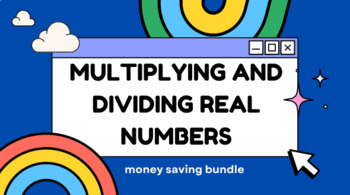Unit 1: Algebra Foundations | Multiplying & Dividing Real Number | Bundle
- Google Docs™

Products in this Bundle (3)
Also included in
- Save time and money with this bundle! It offers all our easy-to-edit worksheets and includes all three levels: entry, emerging, and expert. Students are often overwhelmed by the complexity of many current programs and math education trends. Math is a story that must unfold at a pace students underPrice $356.68Original Price $509.55Save $152.87
Description
Multiplying and dividing real numbers is a lacking skill for many students. The purpose of the bundle is to build not only a student's skill but their confidence. This bundle starts with easy problems and adds layers of complexity so students progress at a manageable rate. When students have a firm grasp of multiplication and division, they can move on to the next standard in the math sequence with a much higher degree of efficacy.
Save time and money with this bundle! It offers increasing rigor at an appropriate pace. Students are often overwhelmed by the complexity of many current programs and math education trends. Math is a story that must unfold at a pace students understand. Like you, I want all students to succeed in math, so I created these worksheets.
When used with other worksheets from Algebra Help Desk, these worksheets are carefully designed to lead students through the challenges of Algebra 1. The goal is to make differentiation easy in the math classroom. As you know, differentiation is a critical high-impact teaching strategy that takes time to plan for. These worksheets make it easy. You can use the same level for homogeneous grouping or combine levels for peer tutoring, skill-based, or another grouping.
- Entry problems are straightforward. The goal is for students to discern mathematical patterns and develop basic math skills. Typically, there is no twist or turns with these problems. These problems are perfect for individual work, Google Classroom, or introduction.
- Emerging problems are simple but challenging. They are typical problems with slight twists and turns. They are challenging enough to make students think without turning them off to math. These problems are good for peer tutoring, stations, or group work.
- Expert problems are complex and challenging. They are thinking problems and allow students to apply what they have learned. With these problems, students are expected to make connections and inferences. These problems are designed to be extensions for students looking for a challenge.
Each level has five different worksheets! That is 15 worksheets for your students. All worksheets on Google Docs make it easy to make minor adjustments for your students, and they are easily uploaded to Google Classroom. If you are a Microsoft Word teacher, you can convert these Google Docs to Word Documents with just a few clicks.






